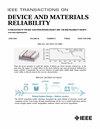提高RRAM可靠性:探索Al掺杂对hfo2基器件的影响
IF 2.3
3区 工程技术
Q2 ENGINEERING, ELECTRICAL & ELECTRONIC
IEEE Transactions on Device and Materials Reliability
Pub Date : 2025-06-18
DOI:10.1109/TDMR.2025.3581061
引用次数: 0
摘要
本研究提供了基于HfO2和al掺杂HfO2绝缘体的RRAM器件的综合评估,重点关注关键性能指标,包括成形成收率,编程后稳定性(PPS),快速漂移,耐久性和高温保留($125~{^{\circ}}$ C)。铝掺杂显著提高了器件的可靠性和稳定性,提高了成形率,减少了编程和保留测试期间的电流漂移,并最大限度地减少了耐力循环期间的可变性。虽然与纯HfO2相比,Al5%:HfO2实现了大部分可观察到的优势,但Al7%:HfO2为需要极高可靠性的场景提供了增量优势。这些发现将al掺杂HfO2器件定位为基于内存和神经形态计算的rram系统的有前途的解决方案,突出了性能提升和制造复杂性增加之间的潜在权衡。这项工作强调了材料工程在特定应用环境中优化RRAM器件的重要性。本文章由计算机程序翻译,如有差异,请以英文原文为准。
Enhancing RRAM Reliability: Exploring the Effects of Al Doping on HfO2-Based Devices
This study provides a comprehensive evaluation of RRAM devices based on HfO2 and Al-doped HfO2 insulators, focusing on critical performance metrics, including Forming yield, Post-Programming Stability (PPS), Fast Drift, Endurance, and Retention at elevated temperatures ( $125~{^{\circ }}$ C). Aluminum doping significantly enhances device reliability and stability, improving Forming yield, reducing current drift during programming and Retention tests, and minimizing variability during Endurance cycling. While Al5%:HfO2 achieves most of the observed benefits compared to pure HfO2, Al7%:HfO2 offers incremental advantages for scenarios requiring extreme reliability. These findings position Al-doped HfO2 devices as a promising solution for RRAM-based systems in memory and neuromorphic computing, highlighting the potential trade-off between performance gains and increased fabrication complexity. This work underlines the importance of material engineering for optimizing RRAM devices in application-specific contexts.
求助全文
通过发布文献求助,成功后即可免费获取论文全文。
去求助
来源期刊

IEEE Transactions on Device and Materials Reliability
工程技术-工程:电子与电气
CiteScore
4.80
自引率
5.00%
发文量
71
审稿时长
6-12 weeks
期刊介绍:
The scope of the publication includes, but is not limited to Reliability of: Devices, Materials, Processes, Interfaces, Integrated Microsystems (including MEMS & Sensors), Transistors, Technology (CMOS, BiCMOS, etc.), Integrated Circuits (IC, SSI, MSI, LSI, ULSI, ELSI, etc.), Thin Film Transistor Applications. The measurement and understanding of the reliability of such entities at each phase, from the concept stage through research and development and into manufacturing scale-up, provides the overall database on the reliability of the devices, materials, processes, package and other necessities for the successful introduction of a product to market. This reliability database is the foundation for a quality product, which meets customer expectation. A product so developed has high reliability. High quality will be achieved because product weaknesses will have been found (root cause analysis) and designed out of the final product. This process of ever increasing reliability and quality will result in a superior product. In the end, reliability and quality are not one thing; but in a sense everything, which can be or has to be done to guarantee that the product successfully performs in the field under customer conditions. Our goal is to capture these advances. An additional objective is to focus cross fertilized communication in the state of the art of reliability of electronic materials and devices and provide fundamental understanding of basic phenomena that affect reliability. In addition, the publication is a forum for interdisciplinary studies on reliability. An overall goal is to provide leading edge/state of the art information, which is critically relevant to the creation of reliable products.
 求助内容:
求助内容: 应助结果提醒方式:
应助结果提醒方式:


